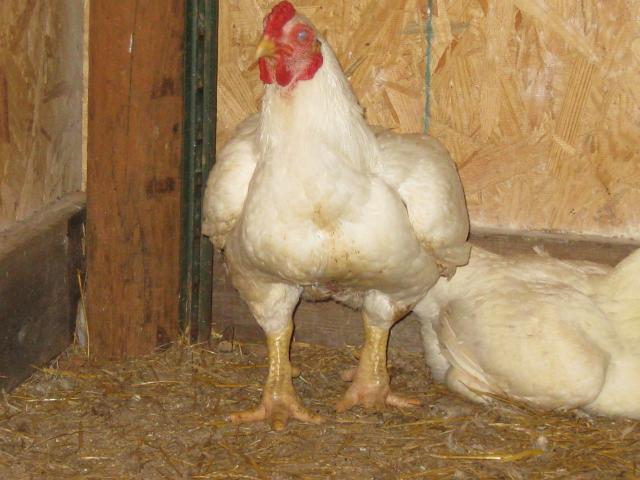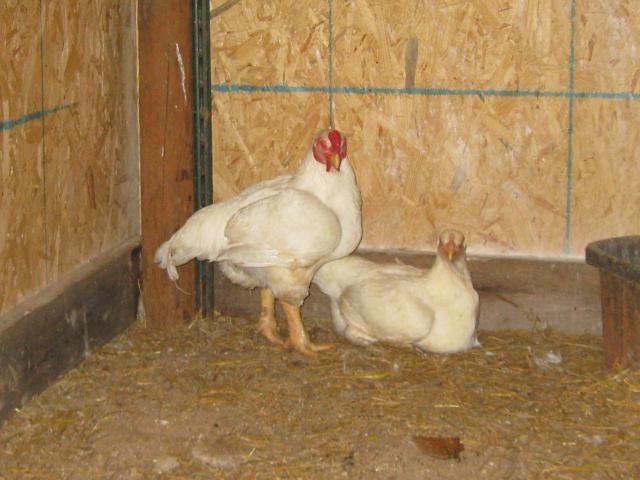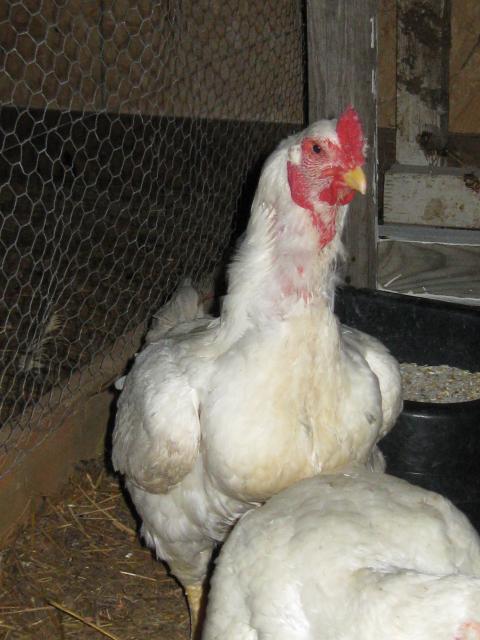I do have a trio of dark also but no pics yet.
Navigation
Install the app
How to install the app on iOS
Follow along with the video below to see how to install our site as a web app on your home screen.
Note: This feature may not be available in some browsers.
More options
You are using an out of date browser. It may not display this or other websites correctly.
You should upgrade or use an alternative browser.
You should upgrade or use an alternative browser.
Red Laced Cornish X and project talk (pics p. 8)
- Thread starter KatyTheChickenLady
- Start date
Quote:
Those whites are exactly what I'm looking for . I'd love to see the darks also .
Those whites are exactly what I'm looking for . I'd love to see the darks also .
Beautiful birds I really like the Whites and the second red laced he's a looker
At 5 days the the hatchery strain WLRC are starting to lag behind the rest a bit in growth . The three smallest were showing a little black around their vents and after a storm I lost power to my brooder for over 4 hours on Fri nite . My best efforts still saw air temps drop to 79 in their brooder and one WLRC was obviosly under duress and suffering from pastey butt when power was restored . I cleaned his vent , allowing him a giant poop , then dressed his sore vent with Preperation H to help with the swelling and stop the build up of poop on the down . I did the same to another even though he was a acting normal . While all are acting healthy now , several more WLRC are now showing pastey butt while the CX and EE are not . I guess my WLRC are just a little less hardy than my others . I couldn't help but wonder if the 24% protein was too high for them so I started giving them a little dry oatmeal as scratch and offered them some parakeet grit , both of which they all tore in to , then lowered them all to 21% feed today .
Last edited:
Quote:
Be sure to share the pic if you get it, I would love to see it.
As for you question regarding qualities I am trying to avoid: first I am trying to size down the CX's I have, extend their growing time and wind up with an edible AND breedable bird. I am just guessing, but adding a heavily muscled bird back in at this juncture seems counter productive to my goal. Also I want more height; longer legs. I haven't seen a Cornish roo that I think could get up on my monster girls. And I want a bird that feathers out quickly then puts on growth, allowing them to be kicked out of the brooder at the earliest age possible. I may still use cornish hens under the roos I come up with, but that will be next year if I do . . . still debating that step.
 thanks for asking!
thanks for asking!
If you're crossing have you considered Delaware? They are fast featherers, great growth rate, and there are breeders out there that keep lines closer to the utility or production body types. There was a guy years ago that created a Corndell from this crossing. He claimed to have produced a self breeding cornishX type broiler. He moved out of the country and the work was lost. But, he did sort of prove that that cross worked.
Just a note about the red laced cornish for those curious. The red laced cornish is a dark cornish pattern with dominant white. For those trying to get solid white progeny (or avoid it): Crossing with a solid black (silver) will get all white progeny in the first generation. For those trying to breed their own white broiler this might be helpful.
For those of you who have crossed standard cornish, how profound is the inheritance of the cornish breast type on the progeny? How well does that trait pass on? There is a lot of info out there about color genetics but very little about conformation and muscling.
Be sure to share the pic if you get it, I would love to see it.
As for you question regarding qualities I am trying to avoid: first I am trying to size down the CX's I have, extend their growing time and wind up with an edible AND breedable bird. I am just guessing, but adding a heavily muscled bird back in at this juncture seems counter productive to my goal. Also I want more height; longer legs. I haven't seen a Cornish roo that I think could get up on my monster girls. And I want a bird that feathers out quickly then puts on growth, allowing them to be kicked out of the brooder at the earliest age possible. I may still use cornish hens under the roos I come up with, but that will be next year if I do . . . still debating that step.

If you're crossing have you considered Delaware? They are fast featherers, great growth rate, and there are breeders out there that keep lines closer to the utility or production body types. There was a guy years ago that created a Corndell from this crossing. He claimed to have produced a self breeding cornishX type broiler. He moved out of the country and the work was lost. But, he did sort of prove that that cross worked.
Just a note about the red laced cornish for those curious. The red laced cornish is a dark cornish pattern with dominant white. For those trying to get solid white progeny (or avoid it): Crossing with a solid black (silver) will get all white progeny in the first generation. For those trying to breed their own white broiler this might be helpful.
For those of you who have crossed standard cornish, how profound is the inheritance of the cornish breast type on the progeny? How well does that trait pass on? There is a lot of info out there about color genetics but very little about conformation and muscling.
Quote:
- Thread starter
- #57
Quote:
why?
why?
Quote:
why?
Its an old time breeding practice to add size and muscle through the male in the initial cross and maternal qualities such as twinning , litter size , mothering instincts , etc. through the female . Its not 100% , but after scoffing at some of the very successful old breeders beliefs decided to try things their way and believe on average the results proove their success was no accident . I also fully believe that the closer the two sides are to your final goal the less culling and refining is needed to get to a strain that consistantly breeds true to the goal . If I cross Leghorn and Cornish and get Leghorn body type with hens that lay 3 dozen eggs per season I would consider that a failure
 , old timers [ and I'm translating mammal breeding to chickens because I don't even know any chicken breeders ] would tell you that if you use the Cornish roo on the Leghorn hens it will maximize the chances of getting meaty chickens with better laying abilities ; I also believe its likely that the chicks from this cross will produce a wide range of types and qualities when crossed together for the F2 generation . Of course what I think should happen and what does happen is not always the same
, old timers [ and I'm translating mammal breeding to chickens because I don't even know any chicken breeders ] would tell you that if you use the Cornish roo on the Leghorn hens it will maximize the chances of getting meaty chickens with better laying abilities ; I also believe its likely that the chicks from this cross will produce a wide range of types and qualities when crossed together for the F2 generation . Of course what I think should happen and what does happen is not always the same

why?
Its an old time breeding practice to add size and muscle through the male in the initial cross and maternal qualities such as twinning , litter size , mothering instincts , etc. through the female . Its not 100% , but after scoffing at some of the very successful old breeders beliefs decided to try things their way and believe on average the results proove their success was no accident . I also fully believe that the closer the two sides are to your final goal the less culling and refining is needed to get to a strain that consistantly breeds true to the goal . If I cross Leghorn and Cornish and get Leghorn body type with hens that lay 3 dozen eggs per season I would consider that a failure


Last edited:
- May 13, 2008
- 10,684
- 193
- 321
Pepper 48-48 has some very very nice stock we got some of our birds from the same breeder who is no longer in Business. I think we are both a tad partial to the whites, they look so cool and are so very rare and hard to find let alone get any, Mine as Charley's are also not for sale as both of us are breeding for some numbers on the ground right now. Fertility for us is an issue right now, I am working on breeding a longer leg to improve that issue.
AL
Me & Pepper 48-48 with some of our whites the day we traveled to get them.

My whites.



AL
Me & Pepper 48-48 with some of our whites the day we traveled to get them.

My whites.



- Thread starter
- #60
AWESOME looking birds guys!
New posts New threads Active threads
-
Latest posts
-
-
I regret pea gravel, need advice.
- Latest: Crazy Chicken Keeper
-
-
Latest threads
-
-
-
Elderly 10.5 year-old Maran chicken -- concerned about her being cold
- Started by Holly67
- Replies: 2
-
-
I regret pea gravel, need advice.
- Started by duckmamaruu
- Replies: 2
-
-
Threads with more replies in the last 15 days
-
×

